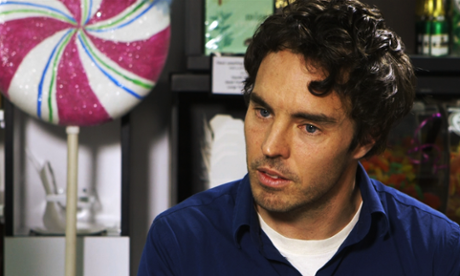
Actor Damon Gameau strapped drugs to Matthew Newton’s stomach in Underbelly and received an AFI nomination for playing hard-nosed news reporter Greg Shackleton in Balibo. But his latest film uses a little more method than he’s used to.
“Not even Daniel Day-Lewis could act fatty liver disease,” says Gameau, who received just that – and several other blows to his wellbeing – after indulging for 60 days in a Super Size Me-esque stunt to test the effect of sugar on his body.
The premise of That Sugar Film, Gameau’s debut as a feature film-maker and documentarian, rests on a decision three years ago to eliminate refined sugar from his diet. This means the slate was clean to test what would happen if he returned to the sweet stuff. In short: aforementioned liver disease, 10cm of visceral fat around his waist, mood swings and (according to doctors) early signs of what could lead to coronary problems.
The twist is that Gameau didn’t splurge on sloppy nosh such as cheeseburgers, chips and sundaes – in other words food everybody knows is bad for you. Gameau consumed the typical Australian’s 40 teaspoons of sugar a day, maintained exercise, the same kilojoule intake of his regular diet and – the clincher – only ate foods perceived to be healthy. This includes cereal, smoothies, muesli bars and low-fat yoghurt. The kind of products at the heart of advertising campaigns built on extolling their supposed virtues, using faux science and deceptive packaging.
“If I’d gone and consumed Mars bars and Cokes the whole time I think we all would know I’d have had ill effects. We get that,” he says. “Where people have been duped is around the lack of integrity and accountability in labelling. You see some of these products in the supermarket with a sunset on them. Or words like Mother Nature and a bee and a flower or something. And people believe it.”
Gameau says the worst effect of the diet was on his cognition, mood and ability to concentrate. “I’d be fine once I had the sugar and then about 45 minutes later I’d get the feeling of being vague and aloof. I didn’t expect that to happen so dramatically. Especially towards the end. It took a toll emotionally.”
Running parallel to the gonzo activist’s mission to map his mental and physical disintegration was a determination to package the experiment in fun and broadly accessible ways. Gameau may have taken to heart Oscar Wilde’s quip that if you want to tell people the truth, make them laugh otherwise they’ll kill you. Or more aptly, that a spoonful of sugar helps the medicine go down.
That Sugar Film looks glossy and effervescent, and comes lathered with flashy, special-effects eye candy. Digitally animated segments see Gameau climb inside his own liver and brain (up a rope and into his own nostril, no less) to illustrate the effect sugar has on your body. Footage of experts is playfully integrated with food packaging. A doctor, for example, might speak from inside a milk carton label or a cereal box, giving some razzle-dazzle to otherwise ordinary talking head interviews.
Gameau demonstrates that the aesthetic of sugar lends itself to a playful, saturated, Willy Wonka style. In a delicious parallel, the same kind of tricks food and beverage companies use to sell their products. Unsurprisingly, they declined to be interviewed. “Coke weren’t interested. We pursued that early on,” says Gameau. “I think a lot of them thought it was going to be Michael Moore style, quite fear-based and slanderous. I hope that we haven’t gone that way.”
Despise the Wonka-esque showmanship, Gameau doesn’t shy away from provocative images and big statements. He links what he regards as a sugar epidemic to nicotine addiction, and argues consumption of it devastated an Aboriginal community in the Northern Territory, where he visits a graveyard and associates blame for deceased people with their sugar intake.
It’s not as if the products associated with this sort of damage are disguised or their labels blurred. In supermarket aisles, at home and on the road Gameau makes a feast (no pun intended) of showing clearly identifiable products and brands: Up & Go, Big M, Prima, Sanitarium, Heinz, Tip Top, Fruche and Kellogg’s to name only a few.
For legal advice Gameau consulted heavily with Spurlock, who in a sense took it a step further by chastising McDonald’s while filming himself inside its own restaurants. The team also consulted with a range of lawyers. “All I was doing is actually interpreting the labels to the public. It’s all there on the packet, it’s just very hard for people to see,” Gameau says. “The consensus was that as long as we were being truthful and nothing was being stretched or exaggerated we fell into the realms of safety.
“So far it’s been alright. I’ll let you know once the film’s out. It might be a very different conversation.”
Like a number of recent “make a difference” advocacy-umentaries (including Food, Inc, The Cove, GasLand and Chasing Ice), That Sugar Film concludes with an empowering message asking audiences to understand that they can make a difference. In this case that food companies are at their mercy, not the other way around.
“We’ve been led to believe these companies have all these powers and are very persuasive in their advertising,” Gameau says. “But at the end of the day you make that movement from your hand to your mouth and you can override all the signals they are giving you.”
• That Sugar Film is touring cinemas across Australia throughout March

